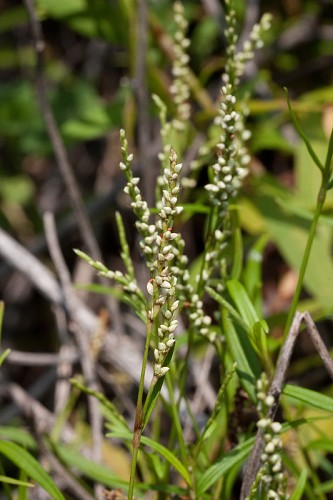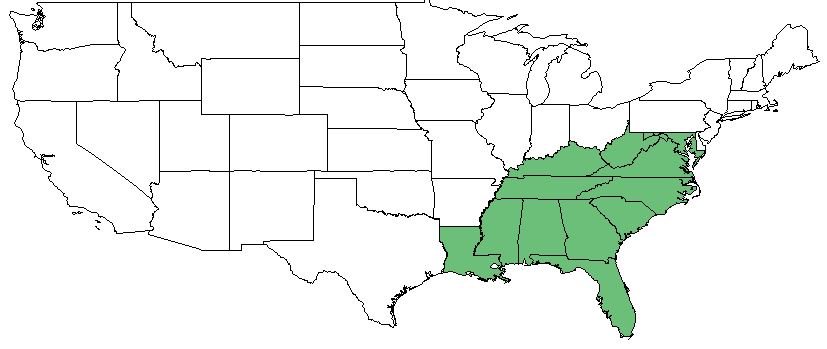Difference between revisions of "Persicaria hydropiperoides"
Emmazeitler (talk | contribs) |
|||
| Line 1: | Line 1: | ||
{{italic title}} | {{italic title}} | ||
| − | Common Names: | + | Common Names: Swamp smartweed,<ref name= "USDA"> [https://plants.usda.gov/core/profile?symbol=CEAM USDA Plant Database]</ref> Waterpepper<ref name="weakley">Weakley, A.S. 2015. Flora of the southern and mid-atlantic states. Working Draft of 21 May 2015. University of North Carolina at Chapel Hill, Chapel Hill, North Carolina.</ref> |
| + | |||
<!-- Get the taxonomy information from the NRCS Plants database --> | <!-- Get the taxonomy information from the NRCS Plants database --> | ||
{{taxobox | {{taxobox | ||
| Line 16: | Line 17: | ||
| binomial_authority = Michx. | | binomial_authority = Michx. | ||
| range_map = PERS_HYDR_DIST.JPG | | range_map = PERS_HYDR_DIST.JPG | ||
| − | | range_map_caption = Natural range of ''Persicaria hydropiperoides'' from Weakley. <ref>Weakley, Alan S. 2015. Flora of the Southern and Mid-Atlantic States: Working Draft of 21 May 2015. University of North Carolina, Chapel Hill, North Carolina. 1320 pp. </ref> | + | | range_map_caption = Natural range of ''Persicaria hydropiperoides'' from Weakley.<ref>Weakley, Alan S. 2015. Flora of the Southern and Mid-Atlantic States: Working Draft of 21 May 2015. University of North Carolina, Chapel Hill, North Carolina. 1320 pp. </ref> |
}} | }} | ||
==Taxonomic Notes== | ==Taxonomic Notes== | ||
| − | + | Synonyms: ''Polygonum hydropiperoides'' Michaux; ''Polygonum hydropiperoides'' var. ''hydropiperoides''; ''Polygonum hydropiperoides'' var. ''breviciliatum''; ''Polygonum hydropiperoides'' var. ''euronotorum'' Fernald; ''Polygonum hydropiperoides'' var. ''opelousanum'' (Riddell ex Small) Riddell ex W. Stone; ''Polygonum opelousanum'' Riddell; ''Persicaria opelousana'' (Riddell ex Small) Small.<ref name="weakley">Weakley, A.S. 2015. Flora of the southern and mid-atlantic states. Working Draft of 21 May 2015. University of North Carolina at Chapel Hill, Chapel Hill, North Carolina.</ref> | |
| − | + | Varieties: none.<ref name="weakley">Weakley, A.S. 2015. Flora of the southern and mid-atlantic states. Working Draft of 21 May 2015. University of North Carolina at Chapel Hill, Chapel Hill, North Carolina.</ref> | |
| − | ==Description== | + | ==Description== <!-- Basic life history facts such as annual/perrenial, monoecious/dioecious, root morphology, seed type, etc. --> |
| − | ''P. hydropiperoides'' is a perennial forb/herb of the Polygonaceae family that is native to North America. <ref name= "USDA"> [https://plants.usda.gov/core/profile?symbol=CEAM USDA Plant Database]</ref> | + | ''P. hydropiperoides'' is a perennial forb/herb of the Polygonaceae family that is native to North America.<ref name= "USDA"> [https://plants.usda.gov/core/profile?symbol=CEAM USDA Plant Database]</ref> It is a rhizomatous perennial that often forms mats. The stems are terrete, with a glabrous or strigose texture, and ends that become erect and floriferous. The leaves are 5-10 cm long and 0.5-2 cm wide with a strigose texture. The base is cuneate, the petioles are 1-5 mm long, and the ocrea are 1 cm long. The nutlets are browns, lustrous, and trigonous.<ref name="weakley">Weakley, A.S. 2015. Flora of the southern and mid-atlantic states. Working Draft of 21 May 2015. University of North Carolina at Chapel Hill, Chapel Hill, North Carolina.</ref> |
| − | |||
==Distribution== | ==Distribution== | ||
| Line 32: | Line 32: | ||
==Ecology== | ==Ecology== | ||
===Habitat=== | ===Habitat=== | ||
| − | ''P. hydropiperoides'' has a high tolerance for anaerobic conditions and fire, but has a low tolerance for drought. It also requires full sunlight, extremely intolerant to shade. <ref name= "USDA"> [https://plants.usda.gov/core/profile?symbol=CEAM USDA Plant Database]</ref> | + | ''P. hydropiperoides'' has a high tolerance for anaerobic conditions and fire, but has a low tolerance for drought. It also requires full sunlight, extremely intolerant to shade.<ref name= "USDA"> [https://plants.usda.gov/core/profile?symbol=CEAM USDA Plant Database]</ref> |
| − | Habitats for ''Persicaria hydropiperoides'' include edges of cypress pond, slash pine flatwoods, and wet swale near bayou. <ref name = "FSU herbarium"> URL: http://herbarium.bio.fsu.edu. Last accessed: June 2018. Collectors: Richard Carter, Sidney McDaniel, Randy Haynes, Michael B. Brooks) States and counties: Georgia (Brantley) Mississippi (Pearl River, Jackson)</ref> | + | Habitats for ''Persicaria hydropiperoides'' include edges of cypress pond, slash pine flatwoods, and wet swale near bayou.<ref name = "FSU herbarium"> URL: http://herbarium.bio.fsu.edu. Last accessed: June 2018. Collectors: Richard Carter, Sidney McDaniel, Randy Haynes, Michael B. Brooks) States and counties: Georgia (Brantley) Mississippi (Pearl River, Jackson)</ref> |
<!--Natural communities, human disturbed habitats, topography, hydrology, soils, light, fire regime requirements for removal of competition, etc.--> | <!--Natural communities, human disturbed habitats, topography, hydrology, soils, light, fire regime requirements for removal of competition, etc.--> | ||
<!--===Phenology===--> <!--Timing off flowering, fruiting, seed dispersal, and environmental triggers. Cite PanFlora website if appropriate: http://www.gilnelson.com/PanFlora/ --> | <!--===Phenology===--> <!--Timing off flowering, fruiting, seed dispersal, and environmental triggers. Cite PanFlora website if appropriate: http://www.gilnelson.com/PanFlora/ --> | ||
| + | This plant flowers from May through November.<ref name="weakley">Weakley, A.S. 2015. Flora of the southern and mid-atlantic states. Working Draft of 21 May 2015. University of North Carolina at Chapel Hill, Chapel Hill, North Carolina.</ref> | ||
| + | |||
<!--===Seed dispersal===--> | <!--===Seed dispersal===--> | ||
===Seed bank and germination=== | ===Seed bank and germination=== | ||
| − | Seeding begins in spring and lasts until the end of summer. <ref name= "USDA"> [https://plants.usda.gov/core/profile?symbol=CEAM USDA Plant Database]</ref> | + | Seeding begins in spring and lasts until the end of summer.<ref name= "USDA"> [https://plants.usda.gov/core/profile?symbol=CEAM USDA Plant Database]</ref> |
<!--===Fire ecology===--> <!--Fire tolerance, fire dependence, adaptive fire responses--> | <!--===Fire ecology===--> <!--Fire tolerance, fire dependence, adaptive fire responses--> | ||
<!--===Pollination===--> | <!--===Pollination===--> | ||
| Line 46: | Line 48: | ||
==Conservation and Management== | ==Conservation and Management== | ||
| − | ''P. hydropiperoides'' is on the threatened list in Indiana and New York. <ref name= "USDA"> [https://plants.usda.gov/core/profile?symbol=CEAM USDA Plant Database]</ref> | + | ''P. hydropiperoides'' is on the threatened list in Indiana and New York.<ref name= "USDA"> [https://plants.usda.gov/core/profile?symbol=CEAM USDA Plant Database]</ref> |
==Cultivation and restoration== | ==Cultivation and restoration== | ||
Revision as of 16:40, 16 November 2020
Common Names: Swamp smartweed,[1] Waterpepper[2]
| Persicaria hydropiperoides | |
|---|---|

| |
| Photo by John Gwaltney hosted at Southeastern Flora.com | |
| Scientific classification | |
| Kingdom: | Plantae |
| Division: | Magnoliophyta - Flowering plants |
| Class: | Magnoliopsida - Dicots |
| Order: | Polygonales |
| Family: | Polygonaceae |
| Genus: | Persicaria |
| Species: | P. hydropiperoides |
| Binomial name | |
| Persicaria hydropiperoides Michx. | |

| |
| Natural range of Persicaria hydropiperoides from Weakley.[3] | |
Contents
Taxonomic Notes
Synonyms: Polygonum hydropiperoides Michaux; Polygonum hydropiperoides var. hydropiperoides; Polygonum hydropiperoides var. breviciliatum; Polygonum hydropiperoides var. euronotorum Fernald; Polygonum hydropiperoides var. opelousanum (Riddell ex Small) Riddell ex W. Stone; Polygonum opelousanum Riddell; Persicaria opelousana (Riddell ex Small) Small.[2]
Varieties: none.[2]
Description
P. hydropiperoides is a perennial forb/herb of the Polygonaceae family that is native to North America.[1] It is a rhizomatous perennial that often forms mats. The stems are terrete, with a glabrous or strigose texture, and ends that become erect and floriferous. The leaves are 5-10 cm long and 0.5-2 cm wide with a strigose texture. The base is cuneate, the petioles are 1-5 mm long, and the ocrea are 1 cm long. The nutlets are browns, lustrous, and trigonous.[2]
Distribution
Persicaria hydropiperoides is native throughout the continental United States excepting Colorado, Wyoming, and Utah, and has been introduced to Alaska. It is also found in British Columbia, Ontario, and Quebec.[1]
Ecology
Habitat
P. hydropiperoides has a high tolerance for anaerobic conditions and fire, but has a low tolerance for drought. It also requires full sunlight, extremely intolerant to shade.[1]
Habitats for Persicaria hydropiperoides include edges of cypress pond, slash pine flatwoods, and wet swale near bayou.[4] This plant flowers from May through November.[2]
Seed bank and germination
Seeding begins in spring and lasts until the end of summer.[1]
Conservation and Management
P. hydropiperoides is on the threatened list in Indiana and New York.[1]
Cultivation and restoration
Photo Gallery
References and notes
- ↑ 1.0 1.1 1.2 1.3 1.4 1.5 USDA Plant Database
- ↑ 2.0 2.1 2.2 2.3 2.4 Weakley, A.S. 2015. Flora of the southern and mid-atlantic states. Working Draft of 21 May 2015. University of North Carolina at Chapel Hill, Chapel Hill, North Carolina.
- ↑ Weakley, Alan S. 2015. Flora of the Southern and Mid-Atlantic States: Working Draft of 21 May 2015. University of North Carolina, Chapel Hill, North Carolina. 1320 pp.
- ↑ URL: http://herbarium.bio.fsu.edu. Last accessed: June 2018. Collectors: Richard Carter, Sidney McDaniel, Randy Haynes, Michael B. Brooks) States and counties: Georgia (Brantley) Mississippi (Pearl River, Jackson)